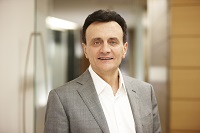 |
| AstraZeneca CEO Pascal Soriot |
AstraZeneca's ($AZN) R&D blueprint for 2015 calls for hunkering down on its core pipeline assets and taking a cue from the startup world with the rest, CEO Pascal Soriot said, planning to partner up in hopes of maximizing value.
Speaking to analysts after another disappointing sales quarter, Soriot said his company is on pace to return to growth by 2017 and execute on some ambitious revenue goals outlined last year.
To get there, AstraZeneca is reprioritizing its pipeline, he said. The big contenders, like the immuno-oncology candidate MEDI4736 and cancer drug AZD9291, will remain the chief focus of its roughly $5.6 billion R&D operation. But for candidates a bit outside of its comfort zone, AstraZeneca will look for partners to split the work or carry the load entirely, Soriot said.
"We'll behave as a biotech company would when it comes to products that are not core," he said, pointing to the company's September deal with Eli Lilly ($LLY) in which AstraZeneca handed over a 50% share of the Alzheimer's disease candidate AZD3293 in exchange for up to $500 million.
The plan relies on the company's internal MedImmune and iMed units to discover new medicines, after which management will vet their potential and decide whether to keep them in-house or start scouting for partners.
Meanwhile, Soriot is sticking to a promise that AstraZeneca can deliver annual revenue above $45 billion by 2023, a number bandied about when the company was fighting off an advance from Pfizer ($PFE) last year. The drugmaker is touting a pipeline of 14 Phase III drugs that will make for 8 to 10 approvals over the next two years. Leading the way is the company's resurgent oncology unit, whose three leading medicines have peak sales potential north of $12 billion on their own, management says.
- read the company's results
- check out the presentation